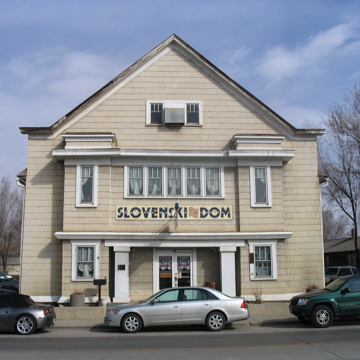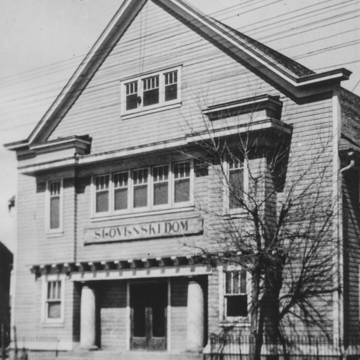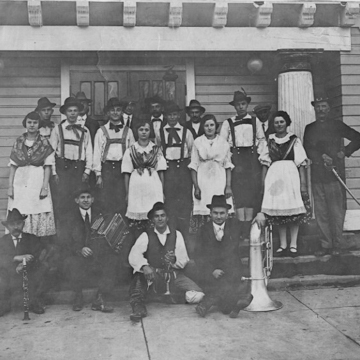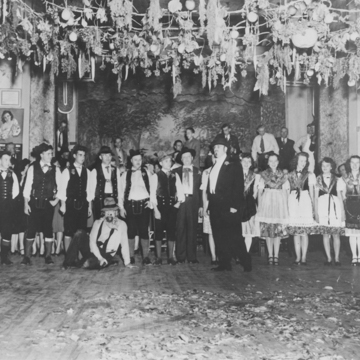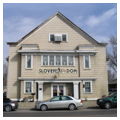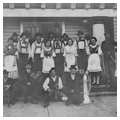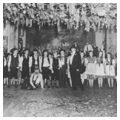You are here
Slovenski Dom
Slovenski Dom in Rock Springs is one of the few ethnic fraternal lodges that remains of the dozens erected during the late nineteenth and early twentieth century in mining towns and camps throughout Wyoming. The Dom was built in 1913 to serve as a public hall and meeting place for several Slovenian-American fraternal lodges in the coal mining town of Rock Springs. The establishment of such buildings, known as “Slovenian National Homes,” was widespread in Slovenian communities throughout the United States. In Rock Springs, the organization’s by-laws stipulated that the lodge would always be known by its Slovenian name, Slovenski Dom, rather than the English translation of Slovenian National Home.
Although very simple in form and execution, the two-story building has distinctive architectural features. Its gable front terminates at each end with a false-front, flared cornice. The symmetrical facade consists of a two-story, portico-like projection with wide piers (each containing a window on the first and second stories) and cornices at each floor. These piers frame the first-floor entryway and a row of five attached windows on the second floor. Original carved wood columns flanking the doorway and brackets on the first floor cornice have been boxed in aluminum siding, and the original novelty siding has been covered with asbestos shingles. However, the original three-over-one double-hung windows remain. A large painted sign below the second-story windows reads “Slovenski Dom.”
Unlike the exterior, the interior of the building retains most of its original finishes such as hardwood floors, plaster walls, dark varnished woodwork, and many original light fixtures. The interior space is divided into halls and meeting rooms of various sizes. The 54 x 41-foot main hall has a curved plaster ceiling and a stage at one end, with a roller-mounted screen featuring a hand-painted scene of a Slovenian castle. A second-floor balcony overlooks the main hall, and was reportedly a favorite vantage point for older women who wished to watch festivities in the hall. Standing on the balcony today it is easy to imagine the bustle and excitement of the crowds at the annual Grape Festival or the New Year's Eve dance.
Smaller rooms at the front of the building (now offices) were originally meeting rooms used by the Slovenski Dom organization, various ethnic lodges (Slovenian, Croatian, and Italian), and the local chapters of the United Mine Workers. Ticket windows on each side were used for special events at the hall. A second large meeting/banquet room runs the width of the second floor. The basement, where the drinks were served, features a 25-foot-long carved wooden and mirrored bar.
It is not known who designed the building, but it was completed in time for a New Year's Eve dance on December 31, 1913. In addition to meetings, Slovenski Dom was used for dances, which were held twice a month (on the miners’ paydays) during the 1930s and 1940s. Often dances and celebrations were preceded by skits performed by a volunteer troupe of young people. Music for the dances was provided by local musicians playing button accordions, tubas, clarinets, pianos, and drums. Traditional foods and drinks were served.
For more than 80 years, the Dom served as the social and cultural heart of the Slovenian community in Rock Springs. Like other mining towns in Wyoming and throughout the country, Rock Springs had a large immigrant population—first of British, Scottish, and Welsh miners, followed by southern and eastern Europeans and Asians, especially Chinese. By the time Slovenski Dom was built, people of south Slavic descent made up as much as one-third of the workforce in the Rock Springs coal mines and nearly one-sixth of the population of Rock Springs.
The Union Pacific Corporation operated the mines in and around Rock Springs. Like many mining companies, Union Pacific deliberately mixed ethnic groups in the mines and in the mining camps and neighborhoods where the miners and their families lived to discourage them from forming ethnic enclaves that might, in turn, lead to labor organizing against the company. To maintain their ethnic identity, immigrants in Rock Springs turned to foodways, language, music, and customs, and they established new, ethnically identified institutions such as church congregations and fraternal lodges.
Immigrant fraternal organizations served both economic and social purposes, providing hospital and death benefits to members as well as providing a social base for immigrants and their children. In Rock Springs, the Slovenian immigrants, along with other ethnic groups including Finns, Croatians, and Tyroleans, formed local chapters of national fraternal lodges or benevolent societies. The Rock Springs Slovenski Dom is the only Slovenian lodge remaining in Wyoming.
The death of the immigrant generation, intermarriage among their descendants, and the closing of the coal mines in the 1950s put an end to the golden age of ethnic life in Rock Springs. However, the ethnic identity and recognition of the cultural diversity that shaped the community persists as a strong element in civic consciousness. The Slovenski Dom is a powerful symbol of the ethnic heritage that built Rock Springs and it still contributes to this identity. The property, which is still owned by the original organization, Slovenski Dom, Inc., is currently leased to an artists’ cooperative (Local Color Gift Gallery) and is accessible to the public during normal business hours.
References
Bogart, Barbara Allen, “Slovenski Dom,” Sweetwater County, Wyoming. National Register of Historic Places Registration Form, 1997. National Park Service, U.S. Department of the Interior, Washington, DC.
Writing Credits
If SAH Archipedia has been useful to you, please consider supporting it.
SAH Archipedia tells the story of the United States through its buildings, landscapes, and cities. This freely available resource empowers the public with authoritative knowledge that deepens their understanding and appreciation of the built environment. But the Society of Architectural Historians, which created SAH Archipedia with University of Virginia Press, needs your support to maintain the high-caliber research, writing, photography, cartography, editing, design, and programming that make SAH Archipedia a trusted online resource available to all who value the history of place, heritage tourism, and learning.














